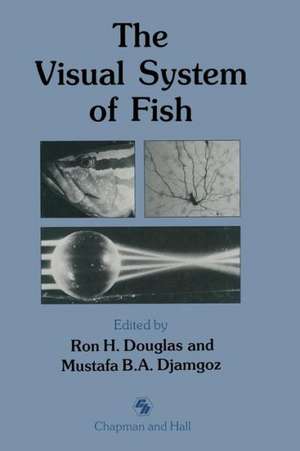The Visual System of Fish
Autor Ron Douglas, Mustafa Djamgozen Limba Engleză Paperback – 26 sep 2011
Preț: 652.49 lei
Preț vechi: 767.63 lei
-15% Nou
Puncte Express: 979
Preț estimativ în valută:
124.87€ • 135.59$ • 104.89£
124.87€ • 135.59$ • 104.89£
Carte tipărită la comandă
Livrare economică 23 aprilie-07 mai
Preluare comenzi: 021 569.72.76
Specificații
ISBN-13: 9789401066723
ISBN-10: 9401066728
Pagini: 544
Ilustrații: XIII, 526 p. 122 illus.
Dimensiuni: 155 x 235 x 29 mm
Greutate: 0.75 kg
Ediția:Softcover reprint of the original 1st ed. 1990
Editura: SPRINGER NETHERLANDS
Colecția Springer
Locul publicării:Dordrecht, Netherlands
ISBN-10: 9401066728
Pagini: 544
Ilustrații: XIII, 526 p. 122 illus.
Dimensiuni: 155 x 235 x 29 mm
Greutate: 0.75 kg
Ediția:Softcover reprint of the original 1st ed. 1990
Editura: SPRINGER NETHERLANDS
Colecția Springer
Locul publicării:Dordrecht, Netherlands
Public țintă
ResearchCuprins
1 The underwater visual environment.- 1.1 Introduction.- 1.2 Definition of terms.- 1.3 The photic environment.- 1.4 Underwater vision and ultraviolet light.- 1.5 Dynamic changes in underwater light - spatiotemporal properties.- 1.6 The underwater polarized light field.- Acknowledgements.- References.- 2 The optical system of fishes.- 2.1 Introduction.- 2.1 Optics.- 2.3 Accommodation.- Acknowledgements.- References.- 3 Optical variability of the fish lens.- 3.1 Introduction.- 3.2 Lens shape.- 3.3 Relative focal length (Matthiessen’s ratio).- 3.4 Spherical aberration.- 3.5 Chromatic aberration.- 3.6 Functional significance of fish lens quality.- 3.7 Concluding remarks.- References.- 4 Visual pigments of fishes.- 4.1 Introduction.- 4.2 Visual pigment structure.- 4.3 Receptor types.- 4.4 Distribution of visual pigments.- References.- 5 Retinal structure of fishes.- 5.1 Introduction.- 5.2 Diversity of retinal structure.- 5.3 Differentiation, structure and connectivity of retinal cells.- 5.4 Cyclic changes of cell morphology in the outer retina.- Acknowledgements.- References.- 6 Electrophysiological characteristics of retinal neurones: synaptic interactions and functional outputs.- 6.1 Introduction.- 6.2 Receptive field organizations: spatial and spectral aspects.- 6.3 Voltage-dependent conductances.- 6.4 Specific synaptic interactions.- 6.5 Efferent inputs.- 6.6 Concluding remarks.- Acknowledgements.- Abbreviations.- References.- 7 Neurotransmitters and neuromodulators of the fish retina.- 7.1 Introduction.- 7.2 Neurotransmitters of the distal retina.- 7.3 Neurotransmitters of the proximal retina.- 7.4 Summary.- Acknowledgements.- Abbreviations.- References.- 8 Tectal morphology: connections, neurones and synapses.- 8.1 Introduction.- 8.2 Retinal projections.- 8.3 Tectalposition and lamination.- 8.4 Tectal afferents.- 8.5 Intrinsic structural organization of the tectum.- 8.6 Tectal efferents.- 8.7 Concluding remarks.- Abbreviations.- References.- 9 The physiology of the teleostean optic tectum.- 9.1 Introduction.- 9.2 General physiological properties.- 9.3 Tectal input pathways: the retinotectal pathway.- 9.4 The marginal fibre pathway.- 9.5 The retinal efferents (retinopetal component).- 9.6 The tectoreticular pathway.- 9.7 Conclusion.- Acknowledgements.- Abbreviations.- References.- 10 The visual pathways and central non-tectal processing.- 10.1 Introduction.- 10.2 Visual structures in the diencephalon including the pretectum.- 10.3 Visual structures in the telencephalon.- 10.4 Visual structures in the ventral mesencephalon.- Acknowledgements.- Abbreviations.- References.- 11 Behavioural studies of fish vision: an analysis of visual capabilities.- 11.1 Introduction.- 11.2 Behavioural methods.- 11.3 Visual capabilities.- References.- 12 Development of the visual system.- 12.1 Introduction.- 12.2 Development of the optics of the eye.- 12.3 Development of the retina.- 12.4 Development of the optic tectum.- References.- 13 Haplochromis burtoni: a case study.- 13.1 Introduction.- 13.2 Visually guided behaviour.- 13.3 Social regulation of growth.- 13.4 Retinal structure.- 13.5 Retinal growth.- 13.6Summary.- Acknowledgements.- References.- 14 Vision in elasmobranchs.- 14.1 Introduction.- 14.2 Physiological optics.- 14.3 Tapetum lucidum.- 14.4 Retinal anatomy and physiology.- 14.5 Concluding remarks.- Acknowledgements.- Abbreviations.- References.- 15 Stimulus, environment and vision in fishes.- 15.1 Introduction.- 15.2 The underwater light environment.- 15.3 Visual adaptations to the environment.- 15.4 Fish as visual stimuli.- 15.5 Summary.- References.- Species index.














